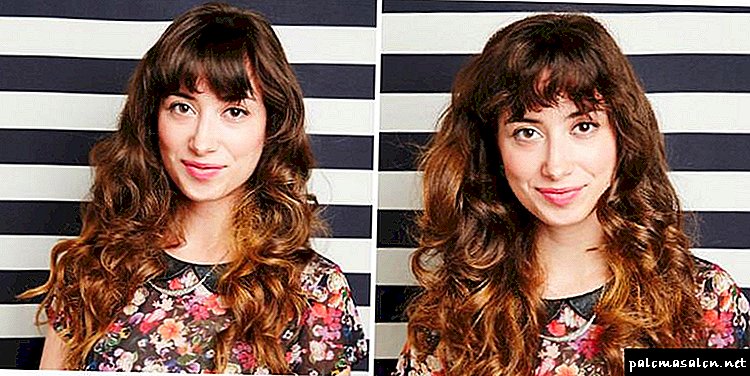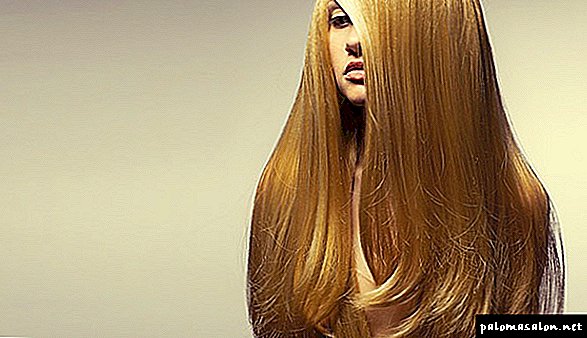Alopecia is a pathological condition characterized by hair loss, which subsequently leads to their substantial thinning or complete disappearance on the head or certain parts of the body.
For a long time, this problem of baldness was observed mainly in males. But in recent years, representatives of the weaker half of humanity have also suffered from it.
What are the reasons for alopecia in women, what is it and how to treat this disease? We will tell about it below.
As in men, alopecia in women (the photo of the disease is presented in this article) is divided into different types. The most common ones are the following:
- androgenic alopecia
- diffuse alopecia,
- focal hair loss,
- cicatricial
Consider the features of each species in more detail.
Androgenic Alopecia in Women
This form of baldness is characterized by thinning of the hair, which leads to their loss in the area of the central parting with further spread to the side zones.
The reasons for the development of such a state lie at the genetic level. Hair loss occurs due to the damaging effects on the hair follicles of such sex hormone as testosterone. It is believed that the tendency to alopecia in 75% of cases is inherited from the mother.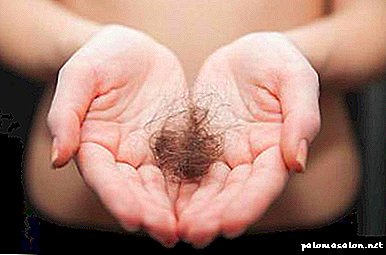
Androgenic alopecia in women is treated the same as in men. For this, drug therapy and transplantation are used.
Alopecia in women - what is it and how to treat it? To begin with it is necessary to reveal the form of this disease.
For diffuse alopecia, uniform hair loss is characteristic. Such a pathological condition arises as a result of failure of cycles in their growth and development.
Due to the fact that this type of baldness is a consequence of impaired work of the whole organism, it is sometimes called symptomatic.
How often does diffuse alopecia occur in women? Reviews report that the weaker sex are more susceptible to it than men.
At present, anagen and telogen type of diffuse alopecia are isolated. The first can cause hormonal disorders, nervous stress, long-term antibiotics, surgeries, strict diets, etc. As for the second type, it occurs when the organism is exposed to faster-acting and strong factors (for example, radiation is radioactive, poisoning by strong poisons, chemotherapy).
As a rule, after the disappearance of the cause of this form of baldness, lost hair is restored within 4-8 months. Therefore, the whole therapy of diffuse alopecia is aimed at finding and eliminating the factors that caused it.
Doctors recommend the use of various growth stimulants, medical balms, sprays, masks and physiotherapy to restore thick hair.
Nesting baldness
Focal alopecia in women, the treatment of which will be presented later, is a pathological hair loss that occurs due to damage to cells of the nervous system and factors of immune protection.
For such baldness is characterized by the appearance of several rounded foci. Also, together with nesting alopecia, patients may experience damage to the nail plates.
Experts say that the cause of the development of such a pathological condition is a genetic predisposition.
Focal alopecia in women: treatment
For the treatment of baldness there are a number of methods and means. However, it should be noted that they were not officially approved.
The most common method of treating alopecia is to use corticosteroids in various forms (for example, in the form of injections, creams, oral medications). Also often use tools that stimulate the formation of their own corticosteroids.
Cicatricial alopecia
Cicatricial alopecia in women - what is it? A distinctive feature of this disease is irreversible damage to the hair follicles, as well as the appearance of scar or so-called connective tissue in their place.
The cause of baldness can be various infections, including viral, bacterial or fungal origin, which cause inflammatory processes around the hair peritrichs.
Experts say that with the timely treatment of such diseases, hair can be preserved.
What other reasons may cause scar alopecia (what it is in women, we have described above)? Quite often, such baldness occurs due to physical injuries, including injuries, chemical or thermal burns.
Method of treatment
There is only one method for treating an already formed cicatricial alopecia. This is a surgical operation. If baldness spots are not too large, then they are removed, and then healthy follicles are transplanted onto them.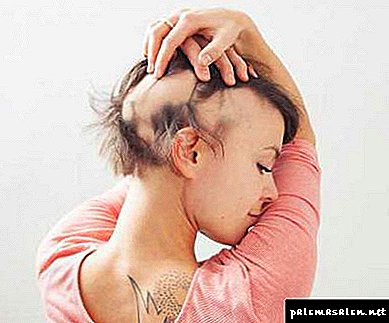
Diagnostics
How is alopecia diagnosed (what is it in women, we told in the presented article)? First you should contact an experienced trichologist. The doctor is obliged to conduct a thorough examination of the hair of the skin and scalp, and then send it to the following tests:
- sex hormone levels
- thyroid gland hormone levels,
- Trichogramma (i.e., a study of hair density per square centimeter of the head with a microvideo camera)
Based on all the data obtained, the trichologist must make a diagnosis and prescribe the appropriate treatment.
Recipes of traditional medicine
How should home alopecia be treated in women? Reviews of specialists state that such methods help only if baldness was not caused by serious pathologists in the body or various infections.
The most popular, simple and affordable folk remedy against alopecia is garlic juice and onions. They are thoroughly rubbed into the affected skin, and after 2-3 hours they are rinsed with water using a shampoo.
Equally affordable for the treatment of baldness are masks with linseed, olive, castor, burdock and camphor oil. They are rubbed into the scalp, and then covered with a bathing cap and left in this form for several hours. Over time, the hair is thoroughly washed.
For a long time, tincture of red pepper has been known for its firming effect. Rubbing this product into areas of baldness every day effectively accelerates the appearance of new hair. However, it should be noted that such drugs are contraindicated in allergies and people with sensitive skin.
According to experts, androgenic alopecia is the most difficult treatment. No advertised masks and shampoos will not be able to restore hormonal balance. Therefore, with this disease should consult a doctor.
Hair transplantation
In that case, if no medical or folk methods help to return the lost curls, then doctors recommend to transplant them.
There are two types of hair transplant operations. Consider them in more detail.
- Strip method This method is characterized by hair transplantation using a skin flap that was cut from a donor site on the back of the head. This flap is cut into grafts, which contains 1-3 bulbs, and then transplanted.
- Seamless or follicular method. This is the most modern way to transplant. To implement it, hair follicles are removed from the donor area using a special tool.With an insufficient amount of hair at the back of the head, the chin, legs, chest, groin area and others can be used as such a site.
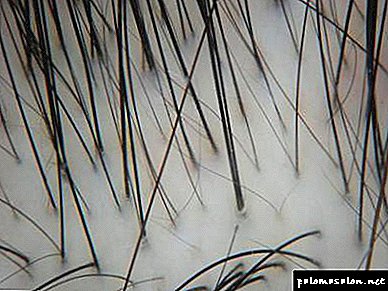
Today, hair transplantation from the donor zone is the only and, perhaps, the most effective method of restoring thick hair and treating alopecia. According to experts, transplanted hairs take root in 95% of cases.
Causes and types of alopecia
In medicine, alopecia, or another name - atrichia - is the official terminology of baldness.
Basically, this is a sharp decrease in the number or a 100% lack of hair on the head through the loss of a complete, or insufficient lack of periods and stages of renewal of cellular growth of hair.
Causes of alopecia in women:
 The consequence of pathological diseases in the complex structure of the central nervous system,
The consequence of pathological diseases in the complex structure of the central nervous system,- Atrophic processes in the bulbs, due to fungal diseases,
- Furunculosis,
- Various kinds of functional disorders of the endocrine glands,
- Congenital malformations of development.
 That is why, without finding out the cause of occurrence, as well as the species classification of Alopecia, the treatment of female pathology at home will not bring any results, and in some cases can even worsen the general background of the disease.
That is why, without finding out the cause of occurrence, as well as the species classification of Alopecia, the treatment of female pathology at home will not bring any results, and in some cases can even worsen the general background of the disease.
The formation of the Atrichia in the female are only three types and two types. It is according to the classification of the species, as well as the nature of the formation that the most probable cause of hair loss is determined, thus the selection of the treatment method becomes much easier.
On a typical basis, Alopecia are non-cicatricial and scar nature:
 With such a pathology as cicatricial Alopecia, there is a total destruction of the bulbs, that is, the hair follicles. This process is caused by inflammatory processes in the follicles themselves, atrophy of the skin, or e scarring. This type of Alopecia is irreversible and no treatment method is suitable for it.
With such a pathology as cicatricial Alopecia, there is a total destruction of the bulbs, that is, the hair follicles. This process is caused by inflammatory processes in the follicles themselves, atrophy of the skin, or e scarring. This type of Alopecia is irreversible and no treatment method is suitable for it.
The process of non-cicatrized alopecia occurs without any previous lesions of the skin.
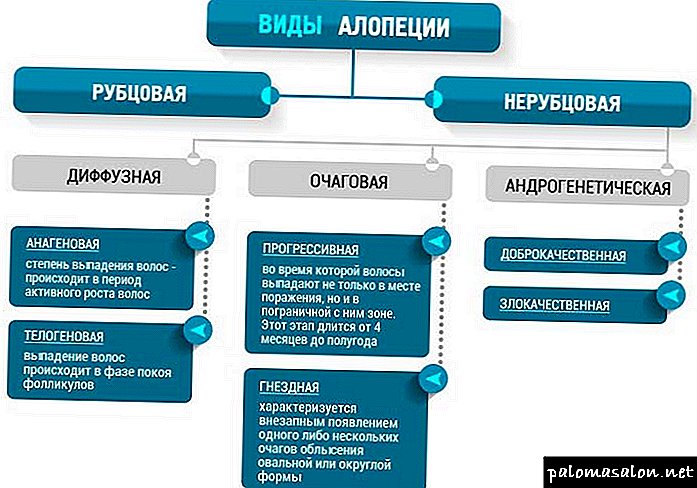
It is formed by only three subspecies:
- Androgenic - that is, androgenetic,
- Diffuse - anagen and telogen,
- Focal - circular and nesting.
Androgenic Atrichia in the female
 Androgenic Atrichia in the female is caused by an excess in the female body of one of the most powerful male hormones dihydrotestosterone (DHT), which stimulates hair loss on the head (androgen-independent hair) and stimulation of growth on the pubis and face (androgen-dependent hair).
Androgenic Atrichia in the female is caused by an excess in the female body of one of the most powerful male hormones dihydrotestosterone (DHT), which stimulates hair loss on the head (androgen-independent hair) and stimulation of growth on the pubis and face (androgen-dependent hair).
Besides:
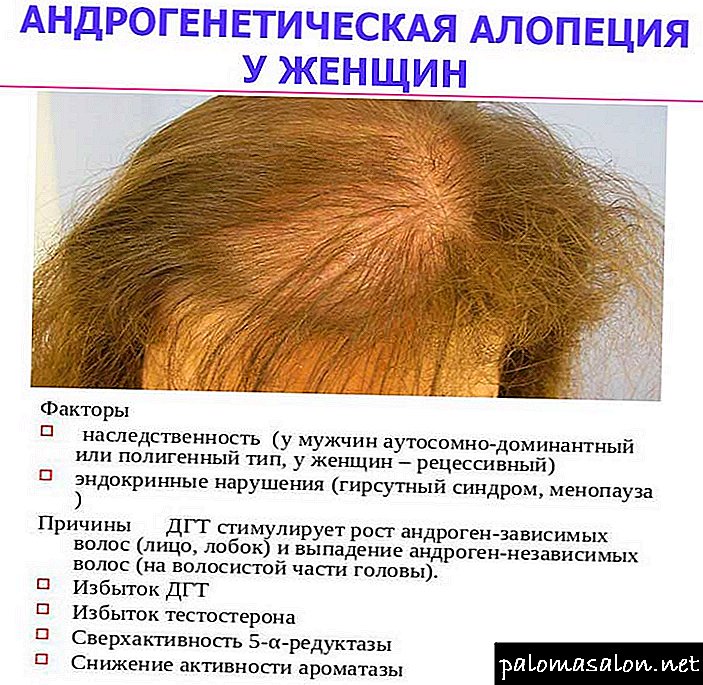 Androgenic activity
Androgenic activity- Reduced estrogen levels.
- Excessive secretion of testosterone in the female body.
The development of the process of a pathological nature occurs gradually. Quite long hair becomes thin and short, and loses pigmentation, which in turn replaces simple vellus, that is, fluff, which disappears completely in time. Already bald areas become shiny and smooth. Hair follicles are missing.
Androgenic Atrichia is often accompanied by inflammation of the skin, seborrhea, and the presence of acne (acne).
 The balding process itself has a consistent development. At the initial stage, a reduction in the number of hairs in the area of the crown is indicated; at the second stage, the borders become wider. Severe baldness can be observed already in the third stage. It can affect a very large part of the crown, while leaving the frontal areas unchanged.
The balding process itself has a consistent development. At the initial stage, a reduction in the number of hairs in the area of the crown is indicated; at the second stage, the borders become wider. Severe baldness can be observed already in the third stage. It can affect a very large part of the crown, while leaving the frontal areas unchanged.
Diffuse Alopecia - Anagen and Telogen species
 At the telogen stage of diffusion of atrichia, an abundant loss of hair is observed. At a certain time, the process is able to intensify, there is a very weak hair renewal, which is caused by the rapid transition of the follicle to the telogen stage, which means rest.
At the telogen stage of diffusion of atrichia, an abundant loss of hair is observed. At a certain time, the process is able to intensify, there is a very weak hair renewal, which is caused by the rapid transition of the follicle to the telogen stage, which means rest.
Every day, quite a large number of hairs is lost, which causes thinning.
Causes of diffuse atrichia in male and female may be the following:
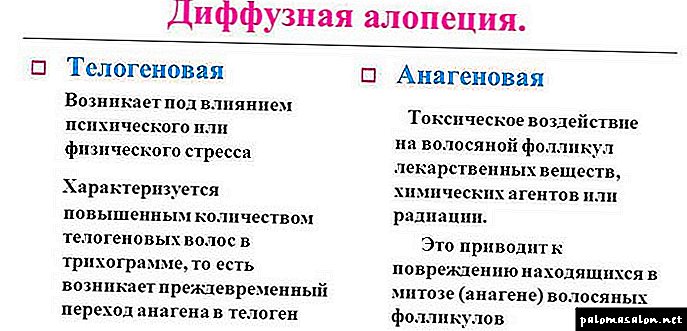 Infectious processes,
Infectious processes,- The aftermath of a tough diet
- Long-term drug treatment,
- Decrease in estrogen level
- Drastic weight loss
- Stress
- Hematological disorders
- Lack of vitamins in the body.
 Provocative factors can activate the development of baldness even after a couple of weeks or months that have passed since the so-called destructive effect. The reaction of the adaptation syndrome of the organism is manifested in all different ways, in accordance with the individual characteristics of the organism. Women risk losing about half of their hair.
Provocative factors can activate the development of baldness even after a couple of weeks or months that have passed since the so-called destructive effect. The reaction of the adaptation syndrome of the organism is manifested in all different ways, in accordance with the individual characteristics of the organism. Women risk losing about half of their hair.
Alopecia in the female with a diffuse form of the disease anagenovogo form is under the accelerated scenario.
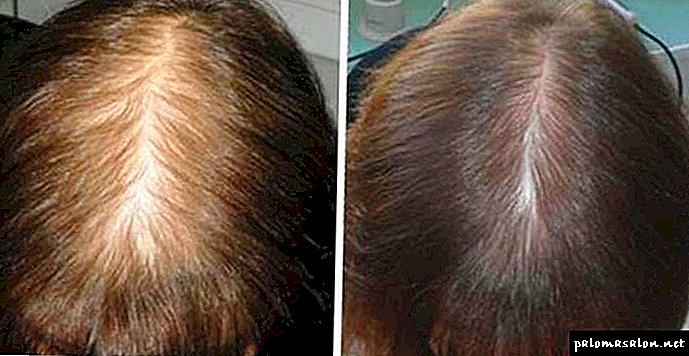 With this kind of disease, hair loss is formed at the stage of anagen, that is, rapid hair growth, and seriously threatens to end in disaster, and the resulting loss of hair. The effects of pesticides, chemotherapy, and radiation often give rise to the rapid development of the disease.
With this kind of disease, hair loss is formed at the stage of anagen, that is, rapid hair growth, and seriously threatens to end in disaster, and the resulting loss of hair. The effects of pesticides, chemotherapy, and radiation often give rise to the rapid development of the disease.
By eliminating all the causes that cause these pathological changes, a person has the ability to completely restore their hair. At this pathological phase, the so-called life cycle of the hair, or rather, their bulbs is not interrupted - even with additional stimulation, the hair can be returned and strengthened.
It is often noted that the structure and color of hair changes, they can become straight if they were curly and so on before.
 Symptoms appear mainly in a linear pattern, that is, the formation of the first strip of alopecia in the dark area of the head, spreading to the area of the temples and forehead. Already through the rather thinning strands of hair one can see the skin. If you do not engage in timely treatment, this polosochka quickly increases in size, while covering the entire head.
Symptoms appear mainly in a linear pattern, that is, the formation of the first strip of alopecia in the dark area of the head, spreading to the area of the temples and forehead. Already through the rather thinning strands of hair one can see the skin. If you do not engage in timely treatment, this polosochka quickly increases in size, while covering the entire head.
The structure of the hair for all this has the same unhealthy appearance. And they are very easy to fall out even with a simple combing.
Gnezdnaya (focal) Atrichia
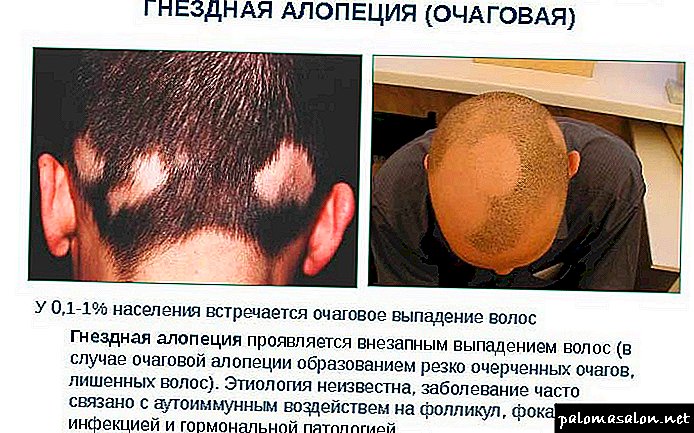 Manifestation of focal alopecia of the nesting character is promoted by infection, genetic predisposition, injuries, stressful situations. It belongs to the simple autoimmune diseases.
Manifestation of focal alopecia of the nesting character is promoted by infection, genetic predisposition, injuries, stressful situations. It belongs to the simple autoimmune diseases.
The disease begins with a rather unexpected focal hair loss, Alopecia areas in the form of nests have clear boundaries, slight reddening of the skin inside these boundaries is possible.
 On the territory of these lesions, seemingly healthy hair can fall out without any effort. A rather characteristic feature of focal atrichia is the manifestation of club-shaped three-millimeter hair processes with split and thickened tips. In some cases, hairline growth is noted in the center of these nests.
On the territory of these lesions, seemingly healthy hair can fall out without any effort. A rather characteristic feature of focal atrichia is the manifestation of club-shaped three-millimeter hair processes with split and thickened tips. In some cases, hairline growth is noted in the center of these nests.
The formation of new foci, merging and expansion of old ones is characteristic.
The duration of the existence of these nest formations is provoked by the dystrophic process in the hair follicles and their atrophy.
In addition to nesting, focal baldness of the disease is formed:
 Ribbon shape - which differs in already clear ribbon-like alopecia from the back of the head to the temples and ears (considered one of the most unfavorable pathology options),
Ribbon shape - which differs in already clear ribbon-like alopecia from the back of the head to the temples and ears (considered one of the most unfavorable pathology options),
Total form - that is, the instant formation and fusion of focal baldness, which lead to the absolute disappearance of hair on the head. The period from the beginning of this process to the final result lasts no more than ninety days. In the early stages, a person has the ability to arrest the process,
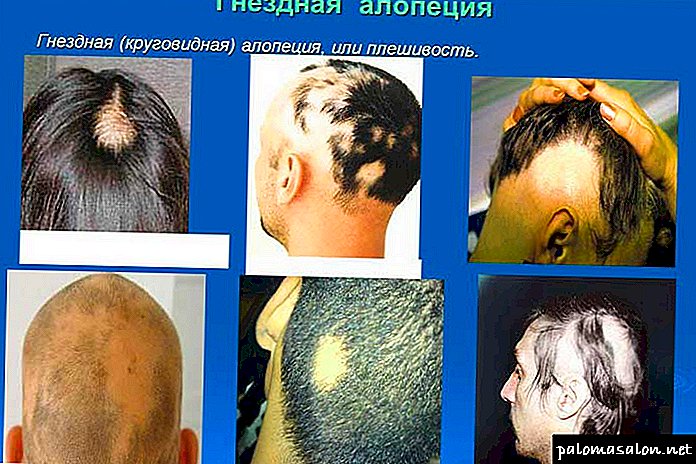 Nest form - which is accompanied by dystrophic changes in autonomic disorders and nail plates,
Nest form - which is accompanied by dystrophic changes in autonomic disorders and nail plates,
Universal form - Atrichia can spread absolutely over the entire surface of the body.Accelerates the formation and further development of the process of pathological nature; the lack of treatment of the disease at the stage of focal formations
 Subtotal form - has a very slow programming, which entails in the process of loss of more than half of the hair, leaving behind only small areas of healthy.
Subtotal form - has a very slow programming, which entails in the process of loss of more than half of the hair, leaving behind only small areas of healthy.
Local form - with the advent of isolated bald formations in focal form.
Alopecia areata has a staged development and a course, the symptoms of education in the female and male sex are absolutely identical.
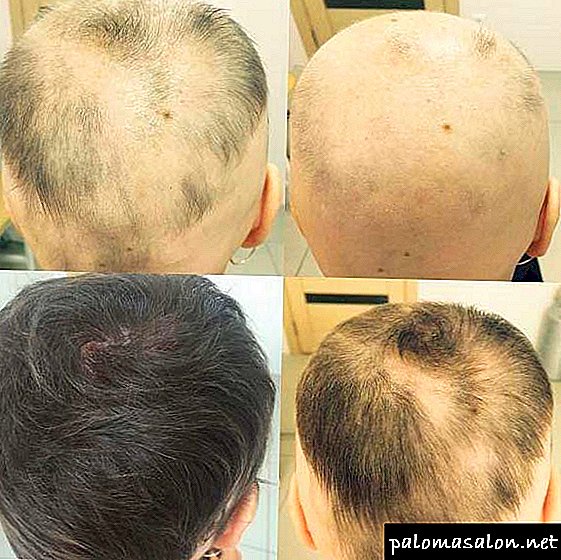 In the progressive stage of the flow, areas of damaged hair are defined simply and clearly. Foci of bald areas in size increase. Ladies have a rather old age with gray hair, mostly only pigmented hair falls out, and the gray hair itself remains untouched. The impression is a one-time graying,
In the progressive stage of the flow, areas of damaged hair are defined simply and clearly. Foci of bald areas in size increase. Ladies have a rather old age with gray hair, mostly only pigmented hair falls out, and the gray hair itself remains untouched. The impression is a one-time graying,- In the stage of progressive flow, foci with down and areas of loose, weakened hair are almost simultaneously detected,
- The regression stage is characterized by the growth of down in already bald areas. Over time, this fluffy hair becomes pigmented and coarse.
- The stationary flow is mainly characterized by a rather unclear definition of areas of damaged hair, or they are not detected at all. Foci are not able to increase in size or decrease, being in a stable condition.
Treatment of Alopecia in Men and Women
 With clear signs of the presence of bald patches and shrinking hair, diagnosis becomes easier. The main measures are aimed at finding the cause, which served the development of pathological changes in the hair. A doctor such as a trichologist is able to find the right direction in diagnosis and explain in detail the scheme for how to treat alopecia of one or another species.
With clear signs of the presence of bald patches and shrinking hair, diagnosis becomes easier. The main measures are aimed at finding the cause, which served the development of pathological changes in the hair. A doctor such as a trichologist is able to find the right direction in diagnosis and explain in detail the scheme for how to treat alopecia of one or another species.
Diagnosis is an important and the first step in the correct and effective treatment of pathology.
Basically, the diagnosis consists of a whole complex of diagnostic tests and methods, which consist of:
 Survey confirming or excluding syphilitic infection
Survey confirming or excluding syphilitic infection- Determination of T and B lymphocytes, as well as tests for easy hair removal, i.e., light curling of curls,
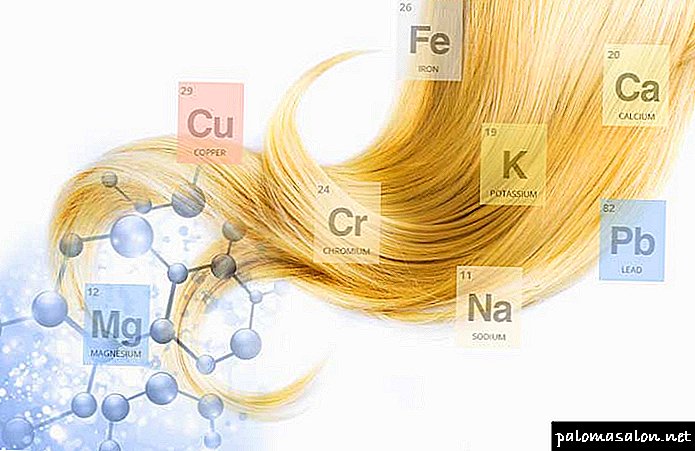 Examination of the biopsy from the areas of damage to the formation of ringworm, cicatricial disease, which develops as a result of granulomatous lesions of sarcoidosis, educational reactions in the skin caused by
Examination of the biopsy from the areas of damage to the formation of ringworm, cicatricial disease, which develops as a result of granulomatous lesions of sarcoidosis, educational reactions in the skin caused by
systemic lupus or lichen planus,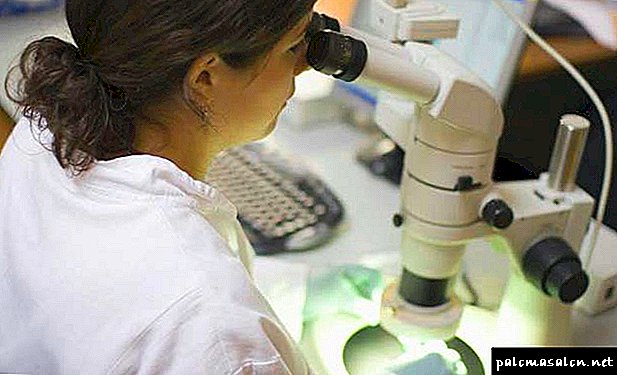 Spectral analysis, which will help detect an excess or deficiency of trace elements in the structural tissues of the hair,
Spectral analysis, which will help detect an excess or deficiency of trace elements in the structural tissues of the hair,- Microscopic examination of the hair shaft and simple bald spots on fungal flora,
- RPR test,
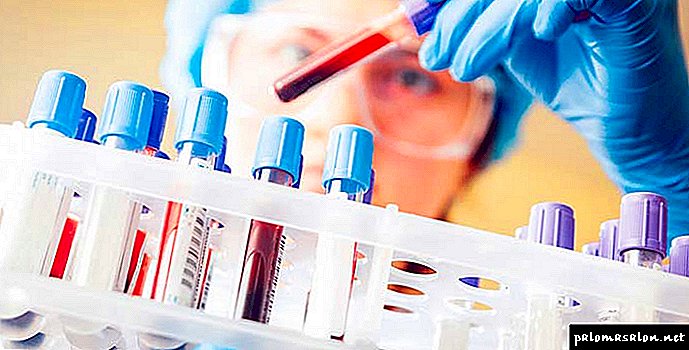 Serological studies
Serological studies- The stages of the examination of the hormonal background, that is, the functional activity of the thyroid gland, the detection of the level of male hormones, the examination of the viability of immune functions.
Treatment methods and drugs
In the treatment of diffuse alopecia, androgenic and nesting character, complex methods are used, which include:
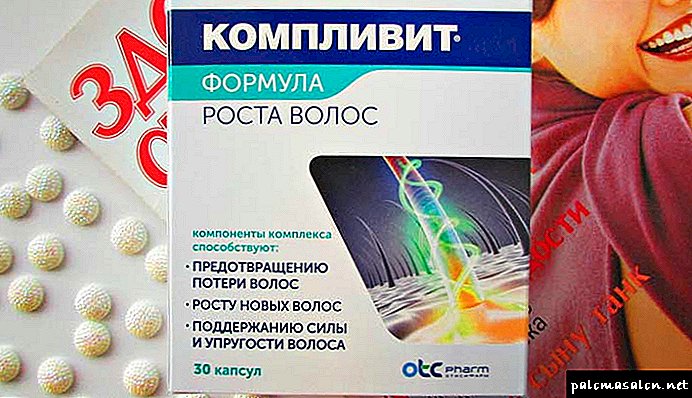 Vitamin and mineral complex, which carries a group of vitamins E and B,
Vitamin and mineral complex, which carries a group of vitamins E and B,- Herbal preparations with the action of irritating forms - mustard, nettle, arnica, and so on,
- The use of hardware method - iontophoresis, microcurrent therapy, electrotrichogenesis, laser therapy, comb
 darsonvalization, galvanization, however, is not used with a pronounced autoimmune component,
darsonvalization, galvanization, however, is not used with a pronounced autoimmune component, - Use of injection mesotherapy,
 Manual methods (we recommend different methods of massage with medical and cosmetic masks, body massage, cryomassage, paraffin masks, lotions).
Manual methods (we recommend different methods of massage with medical and cosmetic masks, body massage, cryomassage, paraffin masks, lotions).- Extracts and tinctures of plant origin, eleutherococcus, kalanchoe, plantain juice, valerian.
- Acceptance of biostimulants, tissue extracts of the placenta, neuropeptides, and so on.
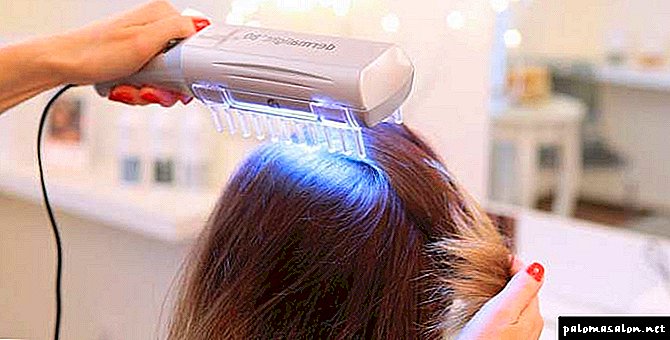 In the treatment of androgenic alopecia in the female sex, hardware methods are prescribed only after the correction of hormones, because they can provoke an increased influx of androgens into the follicles.
In the treatment of androgenic alopecia in the female sex, hardware methods are prescribed only after the correction of hormones, because they can provoke an increased influx of androgens into the follicles.
We advise:
- Microcurrent application,
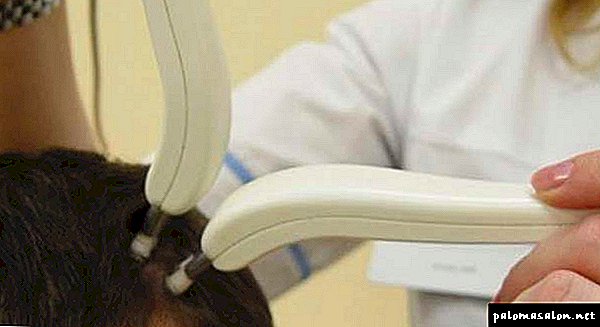 Drugs that block alpha reductase,
Drugs that block alpha reductase,- Biostimulating, strengthening and vasoactive agents,
- Group of natural phytoestrogens,
- Darsonvalization of electrotrichogenesis,
- Methods of photochromotherapy.
In severe disease, various methods of autotransplantation are used.
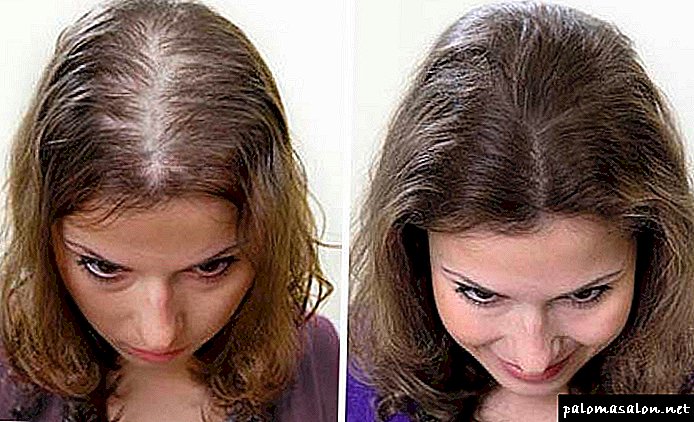 The end and the results of the treatment of alopecia mainly depends on the extent of the affected hair. Complete loss of female hair is considered to be very rare. With androgenic course, the prognosis is almost completely dependent on timeliness, as well as the selection of the correct therapy.
The end and the results of the treatment of alopecia mainly depends on the extent of the affected hair. Complete loss of female hair is considered to be very rare. With androgenic course, the prognosis is almost completely dependent on timeliness, as well as the selection of the correct therapy.
With alopecia of the nesting type, a sufficient number of facts of an unexpected recovery are recorded, however, there are also relapses of the disease.
Unfavorable prognosis in the formation of total alopecia. In this case, the process becomes irreversible.
Types of Alopecia
Taking into account the peculiarities of the nature of alopecia and the reasons for their development, there are several types of alopecia.
Alopecia of this type develops in women under the age of thirty years. For focal type, the formation of oval, round or ribbon-like areas on the head without hair is characteristic. Ignoring the process can cause the formation of multiple foci of baldness, which since time merge into one. Forming the bald spot of a large area.

Alopecia areata passes through three stages of development:
- Active - the skin in the affected area is very inflamed and redden.
- Stationary - there is an active loss of hair.
- Regressive - in the place of already dropped hair, down begins to break through, eventually being replaced by fierce stubble of hair.
A characteristic feature of the nesting type of baldness is suddenly appearing round areas without hair. The process of baldness can not be predicted. Perhaps the emergence of new lesions, and in some cases the process of baldness can be stopped.
The local alopecia is characterized by the appearance of oval-shaped small areas of baldness.
Subtotal
This form of baldness is characterized by a slow process of development. Alopecia covers no more than half the area of the entire hairline. On the head are small areas of healthy hair.
For this form of alopecia characterized by a very rapid formation of foci of baldness. They also quickly merge into one. The result of this process is absolutely bald head.
In total, the process of baldness on the total type takes no more than three months. Because it is important to have time to stop the process of active hair loss at an early stage.
Universal
Alopecia of this type is a progressive form. She is affects not only the head, but all other parts of the body. Start to development is to ignore the process of baldness at the focal stage of development.
Alopecia of diffuse type develops due to radiation or toxic effects on the body. The peculiarity of diffuse baldness - elimination of the cause of alopecia allows you to fully restore the density of the hair.

Androgenetic
This type of baldness provoked by hormonal disorders, increased levels of male sex hormones. The clinical picture of alopecia androgenetic type is manifested in hair loss of the frontal and parietal parts. Especially noticeable signs of alopecia in the area of the central parting.

Attention! In the androgenetic type of alopecia, loss of thickness of the hair coat is primarily associated with thinning hair, and not a decrease in their number.
Drug therapy
 Treatment of the following groups will help to cure the skin and stop hair loss.
Treatment of the following groups will help to cure the skin and stop hair loss.
- Sedatives - normalize the psycho-emotional background.
- Vitamin complexes - saturate the body with missing vitamins and minerals.
- Drugs that normalize the blood supply to tissues.
- The means normalizing a hormonal background. The hormonal drug Diprospan proved itself on the positive side. It is administered subcutaneously over the area of the affected area. The drug has anti-inflammatory effect. Diprospan is indicated for many diseases that cause alopecia in women. The average cost of the drug is 200 rubles.
Physiotherapy
Without resorting to cardinal methods, you can restore the natural density of hair in the following ways:
- galvanization - low voltage current is applied to the skin,
- electrophoresis - nutrition of the skin with necessary substances under the influence of direct electric current,
- darsonvalization - activation of the process of hair growth by magnetic oscillations,
- cryotherapy - effects on the affected areas with liquid nitrogen.
In combination with other methods of treatment, experts recommend doing a massage. It has a beneficial effect on the growth of new hair follicles. Massage is performed with the use of essential oils with your hands or a special comb.
Useful videos
Alopecia (alopecia): definition, rate of hair loss, early alopecia, causes and consequences. A practicing dermatovenerologist Makarchuk Vyacheslav Vasilyevich tells.
Types of baldness (alopecia) on the head, beard, eyebrows, eyelashes. Balding scale.
Etiological factors of disease
A small amount of hairs falls out every day in a healthy person, however, alopecia is characterized by pathological, intense hair loss, which is much higher than normal. The occurrence of alopecia on the head in a woman can be associated with the detrimental effects of external or internal factors (and more often with their combination). The main causes of alopecia in women are:
- Acute or chronic psycho-emotional stress. The normal blood circulation of the scalp is closely related to the nervous regulation, and the microcirculation of the blood worsens due to nervous shocks.
- The lack of nutrients in the diet. Zinc, vitamins of group B, vitamin C, a large number of amino acids are necessary for normal growth and strengthening of hair. If a woman eats irrationally, then this is primarily reflected in the condition of her hair.
- Reception of medicines. Drugs such as slimming drugs, antidepressants and hormone-containing drugs can lead to hair loss in women.
- Hormonal imbalance. Thyroid or ovarian dysfunction. In women, the cause of alopecia is the lack of production of estrogen and thyroid hormones.
- Traumatic damage to the scalp. Burns and wounds lead to the proliferation of connective tissue that does not have hair follicles.
- Dermatomycosis. Fungal damage to the scalp leads to alopecia and a number of other unpleasant symptoms in a woman.
- Chronic infectious and inflammatory diseases. Impaired immunity and the presence of inflammation in the body leads to an intense loss and deterioration of the hairline.
- Disruption of the blood system. Iron deficiency anemia can result in the loss of a large amount of hair, since this pathology has marked hypoxia of all organs and tissues.
- Pregnancy and lactation. During this period, a woman is deficient in many important vitamins and microelements.
If the etiological factor was precisely established, the main therapeutic measures will be aimed at its complete or partial elimination.
Classification and clinical picture
To determine the tactics of further treatment, it is first necessary to determine the type of alopecia. Depending on the clinical picture, androgenic, focal, diffuse and cicatricial alopecia in women is isolated. Also, alopecia of androgenic type is characterized by staged development of the pathological process. To determine the stage of baldness in women, the Ludwig scale is used, according to which 3 stages are distinguished:
- The first stage is characterized by a slight decrease in the amount of hair in the parietal and frontal zone.
- In the second stage, hair thinning is more pronounced.
- The third stage is characterized by significant hair loss in problem areas, up to their complete absence.
Androgenic type of alopecia is most common in men, but women, too, sometimes face this problem. In the development of this type of disease plays an important role imbalance of female and male sex hormones in the body. With an excessive amount of androgens, degenerative changes begin in the hair follicles and scalp of the woman.
The main symptoms of the disease are thinning and discoloration of the hairs, with their gradual replacement with gunfly, which can barely cover the scalp. Mainly frontal and parietal areas are affected, and the occipital zone is practically not involved in the pathological process.
Diffuse female alopecia is characterized by uniform hair loss throughout the scalp. Most often, the pathological process occurs against the background of a serious malfunction of the body. Stress, long-term treatment with some medicines, and the presence of chronic diseases lead to this type of baldness. There are also anagen and telogen form of diffuse alopecia. Anagen type occurs in acute poisoning with toxic substances, after chemotherapy and radiotherapy in cancer patients.
A special type of baldness is focal or nesting alopecia. Depending on the prevalence of the pathological process, it is focal, multifocal, subtotal, total and universal. The basis of the development of the disease is an autoimmune mechanism of damage, as well as genetic predisposition.
Local hair loss can be combined with damage to the nails, which indicates the prevalence of the pathological process.
Sometimes a woman has alopecia after a traumatic injury to the scalp. The so-called cicatricial alopecia appears due to the replacement of the damaged areas with connective tissue that does not have follicles. Such alopecia is clearly localized, hair growth is absent only at the site of injury. May develop after suffering infectious diseases such as syphilis, herpes, lichen planus, leprosy.
How to diagnose the disease in women
Hair loss for a woman is always a severe psychological shock, so it is very important to start an effective treatment in a timely manner. With the problem of hair loss a woman can contact a dermatologist or trichologist. Trichologist is a narrow specialist and is engaged in the diagnosis and treatment of hair diseases, but it is quite difficult to find such a doctor in an ordinary clinic. Sometimes you may need to consult an endocrinologist, a gastroenterologist, a psychologist.
For a start, the doctor will find out the history of the disease, because to make an accurate diagnosis, you need to know when the intensive hair loss started and if a woman connects this phenomenon with any provoking factor. After inspection the doctor sets the form of alopecia and prescribes a series of laboratory and instrumental examinations., to identify the exact cause of the pathological process. A comprehensive examination of the body for alopecia in a woman includes:
- General blood analysis. Allows you to identify anemia, signs of allergies and immune disorders.
- Study of the levels of female and male sex hormones.
- Ultrasound of the thyroid gland and the study of thyroid hormones.
- Hardware study of the structure of the hair shaft under a microscope.
- Conducting a test with the sipping of hair, as an important symptom of alopecia in women is increased hair loss.
- Wasserman reaction (for suspected syphilis).
- Microscopic analysis of scraping from the affected areas of the scalp to identify pathogens of fungal infections.
- Analysis of the biopsy from the affected area eliminates systemic diseases and fungal infections.
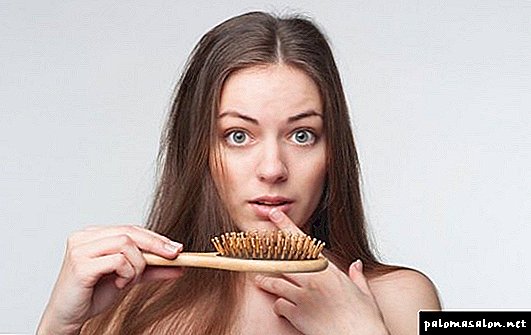
Principles of treatment
Treatment of alopecia is a complex and often lengthy process. With timely treatment to the doctor, correct diagnosis and complete treatment, there are quite high chances to restore hair. If alopecia in a woman has developed after poisoning with toxic substances, radiation or undergoing a course of chemotherapy, then the hair will resume its full growth within 3 months after the cessation of the provoking factor. In other cases an integrated approach to treating alopecia is needed.
In cases where a woman’s baldness occurs on the background of a chronic disease or hormonal failure, therapeutic measures should be directed to the underlying disease. As the woman gradually recovers, the condition of her hair will improve.
If alopecia caused an impaired ovarian or thyroid function, then taking a course of hormone replacement therapy will help restore hair.
Taking iron or vitamin B-12 with anemia will also have a positive effect on the condition of the hair follicles.
Psycho-emotional shock is also a frequent cause of hair loss, in such cases not only agents that affect the scalp, but also psychotherapy are used to treat alopecia in women. Alopecia areata can be a consequence of a fungal infection, therefore anti-mycotic preparations are used for the treatment of local (creams, ointments) and systemic (tablets) use.
Androgenic form of alopecia requires a special approach to treatment. In women, the use of the drug minoxidil, which improves trophism of the scalp, is effective. It is applied locally on the affected areas. Cicatricial alopecia is not amenable to successful conservative treatment and requires surgical intervention.
The most radical treatment for baldness is surgical. Transplantation of one's own hair from other areas of the head is a variant of symptomatic treatment, that is, without identifying the exact cause of hair loss, a relapse may occur. The main types of surgery are patchwork and follicular, sometimes the hairs are taken not from the head, but from other parts of the body (legs, groin area, chest, chin).
In the treatment of alopecia in women, special medical cosmetics and traditional medicine are also used to improve blood circulation and nourish the hair follicles. Developed a whole series of integrated care for the scalp to prevent and slow baldness.
Prevention methods
Every woman dreams for many years to keep a thick and shiny hair.To prevent the development of alopecia, it is necessary to follow simple recommendations:
- Promptly treat diseases of the skin and internal organs.
- Avoid chronic stress.
- Adhere to a healthy lifestyle.
- Choose suitable products for everyday hair and scalp care.
- If there is a genetic predisposition to visit the trichologist to diagnose the condition of the hairline.
- Avoid aggressive procedures such as perms, frequent staining.
- Do not overcool or overheat the scalp (wear a hat in the cold season, do not go to baths and saunas with bare head).
- Buy a high-quality comb that will not pull hair.
Found a bug? Select it and press Ctrl + Enter
What is alopecia in women
If hair falls out on the head, then this disease is called alopecia. To a greater degree it is typical for men, but today there are more cases of its occurrence in women. So alopecia is the loss of scalp hair due to certain pathological processes. The disease causes hair thinning or their complete disappearance in some parts of the head. Alopecia has several varieties:
- diffuse or symptomatic,
- nest or focal,
- androgenetic or androgenic.
Types of female pattern baldness
There is one important feature in female pattern baldness: the causes and treatment depend on the type of alopecia. For the fair sex is characterized by diffuse type, when hair loss is distributed evenly over the surface of the head. A distinctive feature of this type of baldness is reversibility, which allows you to quickly eliminate the cause. In addition to diffuse there is focal and androgenic alopecia, already caused by several other factors.

Bald diffuse type is characterized by the absence of visible bald patches and lesions. With such alopecia, the overall thickness of the hair is reduced, but it does not pose much danger, because it is easily treated if it is noticed at an early stage. In addition, it is divided into 2 more types:
- By type of strip. Initially, a single band appears on the crown, through which the scalp shines through. Then baldness of the forehead and crown takes place, and gradually the temples. If treatment at an early stage is not started, the strip will develop into an oval or round bald patch.
- According to the type of nest. It differs from the first type of accelerated progression, but the hair falls out in the same sequence.
Focal or nesting alopecia causes hair loss in separate areas that become even and smooth. This form of baldness is the most dangerous of all, because the follicles, even after treatment, may not recover. The disease is total in nature: from the merger of the bald patches and the complete disappearance of hair on the head and face, it takes from 48 hours to 3 months, so treatment measures must be urgent.

Androgenic
Male pattern baldness is androgenic alopecia. It is the rarest of all species, but is sometimes found. Such alopecia occurs due to an excess of the male hormone - testosterone. It causes hormonal failure and deactivates the follicles, which then completely atrophy. The prolapse begins at the crown, which leads to the formation of a bald spot. This form of alopecia is very dangerous, because if left untreated, the hair may no longer grow or become very rare.
Causes and provoking factors
Here's what else is important to know about female baldness: the causes and treatment should be fully interrelated to prevent complete hair loss without the possibility of recovery. Like any pathology, alopecia has factors that provoke it. Among them are the following:
- stressful situations
- negative environmental impact
- endocrine system diseases
- cancer pathology,
- unbalanced nutrition
- frequent staining, discoloration, perm,
- hormonal disorders,
- antibiotics or other heavy drugs,
- genetic predisposition
- pregnancy, feeding period,
- fungal infections,
- chronic diseases
- hypothermia of the scalp.
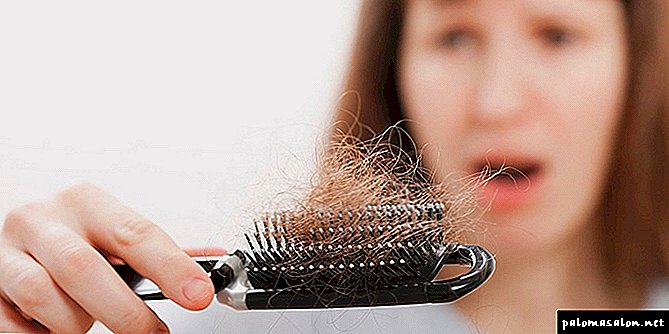
Symptoms of female pattern baldness
Among the common signs of female alopecia are the following:
- more hair loss than usual
- hair thinning of the upper part of the head, passing to the center and back of the head,
- preservation of the front hairline
- skin redness, rarely itching,
- discomfort in the head.
The early stages are characterized by symptoms of hair loss foci, and in addition to the head, still marked on the face. The peculiarity is that the general condition of the woman does not deteriorate and the normal functioning of the body is maintained. The disease is often accompanied by depressive disorders, because for women the appearance is very important, and the bald areas make you feel discomfort and constraint. This situation may be complicated by other serious diseases.
How to treat alopecia in women
Treatment of alopecia in women should have a comprehensive approach, while being prescribed only by a doctor after determining the exact diagnosis. The good news is that there are many methods of both official and traditional medicine. In addition, professional beauty salons offer several effective services that are equally useful. There is an important nuance for female pattern baldness: the causes and treatment must be determined in a timely manner so that the therapy leads to the desired result. For this reason, the doctor must be treated at the first symptoms.

Salon treatments
There are special anti-baldness treatments that provide beauty salons. Only almost all of them have a high cost, and some are still painful, but the effect of them is immediately visible. In addition, it is recommended to consult with a specialist who will determine what to do with hair loss and what procedure will help this. Among the latter are the following:
- ozone therapy
- cryotherapy,
- mesotherapy,
- plazmolifting
- iontophoresis,
- myostimulation.
Mesotherapy
Under this concept lies a cosmetic procedure, which is the introduction of special preparations into the scalp with a very thin needle. Injections are effective in that the vitamins go directly to the hair follicles. This stops hair loss and eliminates dandruff. The procedure lasts about 40 minutes, and the required effect requires 8-10 sessions. Among the side effects may appear small bruises, but very rarely.
Darsonvalization
The darsonvalization procedure has been on the list of popular treatments for baldness for several years. The method consists in exposing the scalp of high-frequency current using a special apparatus, darsonval. The impulses received by the epidermis, dilates blood vessels, accelerates metabolism, improves blood flow. The consequence of these processes is the stabilization of the sebaceous glands and the activation of hair growth. Darsonvalization procedure is used against dandruff, dryness and brittle hair.
Methods of traditional medicine
Comprehensive treatment of baldness includes the methods of traditional medicine, which offers patients masks or decoctions for rinsing the head. Among the most effective are the following recipes:
- Mix 2 pcs. chopped onion with 200 ml of brandy.Daily rub the mixture into the scalp. Appear white hairs shave off so that normal ones appear in their place.
- Pour 0.1 liters of vodka 1 hot red pepper. Leave the mixture for a day, after which use for rubbing into the scalp. After the procedure, go through the affected areas and cut garlic head. With a strong burning sensation immediately rinse the hair thoroughly with warm water.
- Stir 2 tbsp. l burdock or castor oil with 1 tbsp. l mustard powder. After half an hour, apply the mixture on the hair roots, rub until the burning sensation becomes unbearable. After that, thoroughly rinse off the product.
General information
Each person loses from 50 to 100 hairs every day. Hair lives on the head from 3 to 7 years. 90% of hair on the head are actively growing, the remaining 10% are at rest. This phase lasts from 2 to 6 months, after which the hair falls out. Usually with age, the hair does not become thinner, but sometimes new hair does not grow on the site of the lost hair. This process can begin as early as early adulthood. Hair loss can be caused by various diseases, hormonal imbalances, head injuries or scalp injuries, stress or taking certain drugs. Often the hair begins to grow again with the elimination of the cause of loss.
Causes of baldness in women
There are many reasons that can influence the process of baldness in women.
Among the most common are the following:
- Polycystic ovary syndrome. Hair falls out as a result of insufficient estrogen production, while testosterone begins to prevail, which is uncharacteristic for a woman's body.
- Iron-deficiency anemia. Often the lack of hemoglobin and red blood cells is caused by amenorrhea, adherence to strict diets, refusal of food of animal origin, excessive physical exertion. As a result, both the appearance of the woman as a whole and the condition of her hair in particular suffers.
- The period of carrying a child and lactation. First, most of the nutrients entering the woman’s body are spent not on her, but on the fetus. Secondly, a serious hormonal adjustment takes place. Third, a woman suffers from overwork and chronic fatigue. All these three factors negatively affect the condition of the hair, as a result of which they begin to fall out.
- Fungal lesions of the dermis. The vital activity of pathological fungi causes nesting type baldness. Mandatory medical consultation and treatment with antimycotic drugs are required.
- Pathological disorders of the thyroid gland. Hypothyroidism leads primarily to alopecia.
- Frequent stress, nervous system disorders, all this causes a violation of the blood supply to the scalp and leads to alopecia.
- Chronic diseases.
Stages of baldness in women
To determine the stage of baldness in the female used the Ludwig scale. According to it, it is possible to distinguish three stages of alopecia. It manifests with the thinning of the hair shaft in the area of the parting. Then baldness spreads in all directions.
If you want to improve the condition of your hair, special attention should be paid to shampoos that you use. A frightening figure - in 97% of shampoos of famous brands are substances that poison our body. The main components, due to which all the troubles, on the labels are designated as sodium lauryl sulfate, sodium laureth sulfate, coco sulfate. These chemicals destroy the structure of the hair, the hair becomes brittle, lose elasticity and strength, the color fades. But the worst thing is that this filth enters the liver, heart, lungs, accumulates in the organs and can cause cancer. We advise against using the means in which these substances are located.Recently, experts of our editorial staff conducted an analysis of sulfate-free shampoos, where the first place was taken by funds from the company Mulsan Cosmetic. The only manufacturer of all-natural cosmetics. All products are manufactured under strict quality control and certification systems. We recommend to visit the official online store mulsan.ru. If you doubt the naturalness of your cosmetics, check the expiration date, it should not exceed one year of storage.
So, it is customary to distinguish the following stages of alopecia:
- The first stage is characterized by thinning of the hair in the forehead and in the parietal zone.
- The second stage is described as moderately pronounced hair loss in the parietal and frontal zone.
- At the third stage, a pronounced thinning of hair occurs in the described zone. On the sides of the hair remains, but they become much rarer and thinner.
Focal baldness
Focal alopecia is a local hair loss with the formation of lesions of a round or oval shape. This process develops as a result of the fact that immune defense cells begin to infect the cells of the hair roots. There may be several centers of alopecia, but more often it is one.
- Focal,
- Multifocal,
- Subtotal,
- Total,
- Universal nesting alopecia.
In the last stage of the disease, the hair will be lost all over the body. Often in parallel there is damage to the nail plates. The disease develops against the background of a genetic predisposition, under the influence of a number of provocateurs factors. This may be poisoning, stress, vaccine administration, viral diseases, antibiotics, etc.
Diffuse baldness
Diffuse alopecia is a hair loss associated with a pronounced sensitivity of the hair follicle to dihydrotestosterone. It is this sensitivity that becomes the main cause of diffuse alopecia in women in 95% of cases.
The clinical picture can develop in three models of alopecia:
- Alopecia by type of strip, also referred to as I-shaped baldness. In this case, the hair falls out over the entire head, and in the parietal region there appears a clear band, through which the skin is perfectly visible. In parallel, hair falls out in the temples and in the frontal zone. With no treatment, the strip expands and captures the entire parietal zone. The visible area of the scalp is getting bigger.
- Alopecia of the nesting type, or O-shaped baldness,
- Androgenetic female baldness is considered the most dangerous.
As a rule, it is easy for a trichologist to diagnose a diffuse alopecia type. If the disease is ignored, then in the end all the strong hair will be lost, and thin rare rods will remain on the head. A similar condition in trichologists is called the dandelion effect.
Diffuse alopecia can be telogen and anagen. Telogen alopecia is most often provoked by nervous stress, hormonal disruptions, medication, surgery, chronic pathologies, adherence to dietary nutrition. In this form of diffuse alopecia, hair follicles prematurely go into the resting phase.
Anagenic diffuse alopecia occurs as a result of exposure to radiation, chemotherapy, or strong poisons. That is, the factor that caused baldness was fast, and the hair follicles do not have time to go into the rest phase, as a result, the hair dies off and falls out.
Most often, diffuse alopecia passes after the elimination of the causes that provoked it. After a maximum of 9 months, the hair begins to grow back. To accelerate their growth can be applied drugs, in particular, Minoxidil, sprays, medical shampoos and hair masks.
How to stop baldness in women
Treatment of alopecia depends on the cause of it. Therefore, the first step in the fight against hair loss should be a visit to the doctor.It is he who, on the basis of the diagnostic methods, will determine the form of alopecia and outline a treatment plan. Possible methods of combating baldness caused by the pathologies of organs or organ systems are reduced to:
- Therapy of fungal lesions of the scalp antimycotic agents.
- Getting rid of iron deficiency anemia, iron supplements and vitamin therapy.
- Elimination of endocrine pathologies.
- Correction of immune deficiency.
- Getting rid of skin diseases.
- Neurological problem solving.
If a woman has androgenic alopecia, then she is shown to undergo treatment using Minoxidil. The remaining methods of dealing with this genetic disease are ineffective. It should be understood that after cessation of therapy, the hair will most likely be lost again if we are talking about true alopecia, and not about hair loss caused by the disease of other organs.
Shampoos for baldness in women
One of the means of combating hair loss is the use of various shampoos. However, not every detergent really has a healing effect, and it is necessary to apply them correctly.
It is possible to use the tool as a preventive measure with the thymus gland extract contained in it. This ingredient helps fight dihydrotestosterone, which contributes to hair loss. But the fight against baldness can not be fast. Two weeks is not enough to see the effect. Shampoo will need to be applied for a long time, and the first result can be seen not earlier than in a month. In addition, the remedy may not help some people.
Shampoos are available without a prescription, you can find separate products for men and separate for women. They are manufactured under different brands and brands. It is desirable that it contains nutrients that could stimulate and improve the work of the hair follicles. It is better to give preference to well-known manufacturers.
In addition to useful components, components that are harmful for hair growth can be found in shampoos. So, surfactants are dangerous for hair growth, as they have an aggressive effect on hair follicles. In the composition of the shampoo, they can be labeled as sodium lauryl sulfate or SLS. They do not clean the hair from contamination, so if the surfactant is included in the shampoo, it should be abandoned.
In any case, before giving preference to a particular remedy, you should consult a doctor.
Perhaps one of these shampoos will be an excellent means of preventing hair loss:
- Progain is a fairly popular medium produced by Rogain. The composition of this shampoo is Minoxidil.
- Shampoo and tablets for oral administration Provillus. The composition of this complex prophylactic agent includes palmette extract, zinc and magnesium, biotin, and Minoxidil, which has a healing effect in androgenic alopecia.
- A three-component preventive and therapeutic scheme for alopecia can be based on the use of baldness Nioxin. This conditioner, shampoo and a means to treat the dermis. The shampoo and conditioner contains vitamins, proteins and amino acids designed to nourish and thicken hair.. The remedy itself has an effect on the work of dihydrotestosterone. You can choose the most appropriate tool based on the condition of the hair - depending on their damage and the degree of thinning.
- Nizoral Shampoo is an effective remedy to fight fungal skin lesions. It has a wide spectrum of action and effectively eliminates dandruff. There is evidence that Nizoral allows you to deal with androgenic alopecia, but it must be applied on a permanent basis.
- The shampoo, with its dehydrotestosterone blockers, is Revivogen.Active ingredients are metol, palmetto and soy protein. This tool can be used both independently and in combination with other prophylactic and therapeutic shampoos.
Drugs for treating baldness in women
There are many tools for the treatment of alopecia, but it is safe to say that at least one of them will help 100%. According to statistics, the most effective drugs are Minoxidil and Finosterid.
Minoxidil is a liquid product that must be applied to the affected areas of the dermis of the head. Perform the procedure twice a day, which helps to stimulate the hair follicles. As a result, hair growth resumes, the rod itself becomes thicker and remains viable longer. Men can use the drug in a concentration of 5%, and women are not recommended to apply Minoxidil in more than 2% solution. This limitation is explained by the fact that women have an increased risk of facial hair growth.
The mechanism of operation of the tool to the end remains unexplained. However, it is believed that after its application the blood flow to the dormant bulbs increases, as if it awakens them and the hair begins to grow again. However, initially the remedy was created to lower blood pressure. Strengthening hair growth was considered a side effect of taking Minoxidil.
Finasteride is a drug for oral administration. He is released in the presence of a prescription. The main action of Finasteride is the inhibition of the work of dihydrotestosterone, which contributes to hair loss by the type of androgenic alopecia. This drug is advisable to receive only men, because the effect when it is taken by women is simply absent. In addition, it can have a toxic effect on the fetus if it is taken by a pregnant woman.
Corticosteroids are effective drugs for getting rid of alopecia baldness. With this type of alopecia, corticosteroids are injected. The first results can be seen after a month. If there are contraindications to injection, then you can use drugs produced in the form of creams or ointments. However, the effect will be less pronounced.
There is also a cream for getting rid of baldness, its name is Anthralin. It must be applied to the affected areas every day, after a while the cream is washed off. The remedy is effective in treating alopecia focal type. However, about a quarter of patients observe a positive result.
Home treatment
Treatment of focal alopecia in women also includes the use of natural remedies and essential oils. Various essential oils have beneficial properties, and there are many such oils that are effective in restoring hair growth. You can even combine oils such as grape seed oil, lavender, rosemary, cedar and jojoba. Regular massages of the scalp with these oils will help stimulate the resumption of growth, as well as improve the health of the hair. Another method of treatment of focal alopecia at home includes the use of onion juice, which is known to cause an improvement after a couple of months. Onion juice may be applied to the affected areas twice a day.
Folk recipes for hair loss in women
Burdock or castor oil. Half an hour before washing your head, rub the mixture into the head (oil plus alcohol in equal parts). Apply 1-2 months. Another remedy: mix castor oil with medium onion juice and one yolk, apply to hair 45 minutes before washing and cover the head with a bag and towel.
Orange peels. Peel from 2-3 oranges add to water, let it brew for three hours, and then wash your head with this water. The tool helps to give shine and shine and perfectly nourishes the hair.
Pepper mask. 1 chop chili and pour 100 ml of vodka.Insist for 2-3 weeks in a dark place. The resulting tincture can be added to the air conditioner, hair balm, mixed with butter or kefir. In pure form is not used!
Compresses with gifts of nature
- Chop the parsley root thoroughly, squeeze the juice into a glass. Saturate juice with gauze and put it on your head under a warming cap. An hour later, wash the hair with warm water.
- If you have an aloe bush at home, take 2 old leaves, chop and squeeze the juice. Soaked gauze in juice placed on your head, making sure that the juice does not get into the eyes. To do this, wrap the wrap with plastic wrap. Wash the juice in half an hour.
- Pour 100 g of green needles of coniferous tree (spruce, pine, fir) 1 liter of boiling water, warm in a water bath for 20 minutes. Strain the broth and rub into the head for 15 minutes before washing your hair. This recipe not only allows you to treat hair loss in women, but also stimulates the growth of new hairs.
All these methods are aimed at achieving two goals: stop hair loss and stimulate the growth of new hair. As a rule, specialists prescribe complex treatment, which combines both medication and the use of special care products. This approach allows you to get a fairly fast and stable result (from six months to a year).
Remember that only a doctor can prescribe a proper treatment! In no case do not try to solve the problem on your own, as you may aggravate it even more, because practically any medicine has contraindications, and some of the methods may not be suitable for certain reasons.
Hair transplantation
There are situations when neither drug therapy, physiotherapy, nor folk remedies can help stop baldness. A woman has significant bald patches on her head, her hair is thinning and you have to go for various tricks - try to hide flaws under intricate hairstyles and haircuts, use false straps, etc. In the end, all this hurts like a woman's vanity and confidence, she stops feeling attractive and desirable, locks in herself, refuses to appear in public. It would seem that the only way out is to wear a wig. But it is not so! Modern medicine has made great strides forward and today offers effective and painless methods of hair transplantation.
The most delicate and innovative method is HFE (Hand follicul extraction). It consists in the fact that hair follicles are removed from the donor area of the patient with the help of a special microtool (micropanche). Then this donor material is transplanted to baldness areas with the help of a microimplanter. It does not make any cuts, each head is not injured. The only thing that can remain after the procedure is a slight reddening in the transplant zone, but it will also disappear in a few days.
In general, the procedure lasts several hours - depending on the area of the balding area. Local anesthesia is used. Immediately after the completion of the procedure, the patient can go home, the rehabilitation period is not required.
The transplanted hair follicles soon take root, and the woman again grows beautiful hair, at a natural angle of inclination, so that no one ever guesses that she was a patient of a hair transplant clinic.
In addition to HFE, there are other methods of hair transplantation, including graft grafting (skin grafts with hair follicles are cut and stitched to a new place), partially seamless transplantation (follicles are removed without skin traumatization, but micro-cuts are made with a scalpel when they are implanted). But if there is an opportunity - it is better to choose the most modern and reliable method.
Local darsonvalization and laser radiation as methods of treating alopecia
Specialists of all levels note the highest efficiency of the use of Darsonval currents in the fight against alopecia in women and men. The healing effects of high-frequency currents on the skin and hair follicles are known worldwide and are traditionally prescribed for problems with baldness. The use of darsonvalization increases the activity of hair follicles, triggers the processes of hair regrowth, improves the growth of existing hair. In parallel with the current exposure, the scalp ozonization occurs, which contributes to the disinfection and saturation of cells with oxygen.
The increasing popularity of courses in the treatment of alopecia is gaining laser. This method of high-energy light radiation restores hair growth processes, significantly improves their quality. Previously, laser therapy was used only in specialized clinics. But now there are universal portable devices that allow to achieve consistent results in the home.
The currents of darsonval, ozonization, laser radiation also enhance the effectiveness of medical cosmetics, restore the flow of blood to the bulbs. It should be remembered that such a combined effect gives much more visible results than the use of any one method. Now, alopecia in women and men is no longer such a formidable enemy, and anyone who is focused on results can independently cope with this problem. It is only necessary to stock up on desire and patience - and then you will succeed!
Other tips for balding
In addition to medical treatment, there are various cosmetic and protective methods that women can use for severe baldness. These include:
- Using cosmetics to hide or minimize hair loss,
- Wearing wigs, hats or scarves,
- Reduced stress.
Many women who have been diagnosed with focal alopecia have recently had tension and stress in life, such as work, family, loss of a loved one, accidents, etc. However, it has not been scientifically proven that stress is the main cause of focal alopecia.
Prevention of baldness in women
Prevention of baldness - an important stage in the fight against alopecia.
There are some practical tips that can help preserve hair:
- Cosmetic hair restoration will occur no earlier than in 6 months. Therefore, interrupt treatment ahead of time due to lack of results should not be.
- You should lead a healthy lifestyle, give up bad habits, avoid stress.
- Hair growth contributes to taking vitamins of group B.
- Sometimes it helps to prevent hair loss by taking antihistamines. Perhaps you should try to go on a gluten-free diet.
- It is necessary to avoid hypothermia of the dermis of the head, so as not to provoke a spasm of blood vessels. Therefore, in the cold season, the head should be covered.
- Minimize the intake of caffeine.
- It is necessary to reduce the traumatic, thermal and chemical effects on the hair.
If baldness proceeds according to the type of androgenic alopecia, then specific preventive measures do not exist, since it is rather problematic to determine the prognosis for the development of pathology. In this regard, it is necessary to appeal to the trichologist and follow his advice regarding the treatment of a specific form of alopecia.
Alopecia - what is it? A photo

alopecia in women photo 1
In medicine, the official terminology of baldness is alopecia (atrichia). It is characterized by a sharp thinning or complete absence of hair on the head due to loss, insufficient or complete absence of stages and periods of renewal of cellular hair growth (see photo).

The reasons manifestations of alopecia in women are very diverse. May be due to:
- congenital anomalies of development,
- a consequence of a number of pathologies in the complex structure of the central nervous system,
- functional disorders of the endocrine glands,
- atrophic processes in onions, due to fungal diseases,
- manifestation as a consequence of furunculosis.
Therefore, without finding out the causative factor and the specific classification of atrichia, self-treatment of alopecia in women will not bring results at best, at worst, it will aggravate the situation.
The manifestation of alopecia in women are of two types and three varieties. It is for the specific classification and the nature of the manifestation that the possible cause of hair loss is determined and the selection of treatment is facilitated.
According to the typical attribute of atrichia, there are cicatricial and non-cicatricial character.
- When cicatricial alopecia occurs complete destruction of the hair follicles (follicle). This process is caused by inflammatory processes in the follicles, skin atrophy, or scarring. Such atrichia is irreversible and cannot be cured.
- The process of non-cicatrized alopecia takes place without prior skin lesions. It manifests itself in three types - focal alopecia (gnezdnogo, krugovidnoy), androgenic (androgenetic) and diffuse (telogen and anagen).
Diffuse alopecia - telogen and anagen species

At the telogen stage of diffuse alopecia, there is abundant hair loss. At a certain time period, the process may increase, there is a slight hairline renewal, which is caused by the rapid transition of its follicles to the telogen stage (the resting stage).
The daily loss of numerous hairs causes its significant thinning. The cause of diffuse alopecia in both women and men can be:
- lack of vitamins in the body,
- infectious processes
- hematological disorders,
- the effects of a tight diet
- stress and sudden weight loss
- long-term drug treatment,
- decrease in estrogen level.
Provocative factors can trigger the development of baldness after a few weeks and months after their harmful effects. The reaction of the adaptation syndrome of the body is triggered according to individual characteristics. A woman risks losing up to half of her curls.
Alopecia in women with a diffuse form of the disease of the anagen form is a more accelerated scenario.
With this type of disease, the loss of hair is manifested already at the stage of anagen (rapid hair growth), and threatens to end in complete collapse - the final loss of hair. The influence of radioactive radiation, pesticides and chemotherapeutic treatment very often gives impetus to the rapid development of pathology.
When eliminating the causes of pathological changes, you can fully restore hair. At this pathological phase, the life cycle of the hair bulbs is not interrupted, and with their additional stimulation, it is quite possible to update the hair with strong curls.
Often there is a change in the color and structure of the hair, they can be curly, if before that were even and vice versa.
Symptoms of diffuse alopecia manifests itself in a linear fashion - the appearance of the first strip of baldness is noted in the parietal zone of the head, extending to the zone of the forehead and temples. The skin is clearly visible through heavily thinned strands. If you do not engage in timely treatment, the strip on the vertex rapidly expands, covering the entire parietal region of the head.
- The structure of the hair at the same time, has a dull unhealthy appearance. They are easily pulled out when combing.
Focal (Breeding) Alopecia

Stressful situations, infections, injuries and genetic predisposition contribute to the formation of alopecia alopecia of focal nature. It belongs to autoimmune diseases.
The disease begins with a sudden focal loss of curls. The centers of alopecia in the form of nests have a clear outline. Perhaps a slight reddening of the skin inside the bald nests.
Along the edges of the lesions, seemingly healthy hair is easily pulled out without any effort. A characteristic sign of focal alopecia is the appearance of club-shaped three-millimeter hair processes, with thickened and split ends. Sometimes in the center of the nests there is hair growth.
- The appearance of new foci, expansion and merging of old ones is characteristic.

alopecia areata, closeup photo
The duration of the existence of nest foci provokes dystrophic processes in hair bulbs and their atrophy. In addition to focal, alopecia baldness, the disease manifests itself:
- Local form with the manifestation of isolated bald focal lesions.
- Ribbon, different ribbon-like baldness from the occiput to the auricles and temples (a very unfavorable version of the disease).
- Subtotal form - characterized by slow progression, involving in the process of loss of more than half of the scalp, leaving only small areas of growing, healthy strands. Without appropriate treatment of focal alopecia of this form, eyelids and eyebrows are exposed to baldness.
- Total form - which is characterized by the rapid formation and fusion of focal alopecia, leading soon to the complete disappearance of hair. The period from the beginning of the process to the final total result lasts no more than three months. In the early stages it is possible to arrest the process.
- Universal - alopecia spreads over the entire surface of the body. Provokes the development of the pathological process of the lack of treatment of the disease in the stage of focal lesions.
- Nest form accompanied by dystrophic changes in the nail plates and autonomic disorders.
Alopecia areata has a staged course and development, the symptoms of manifestations in men and women are the same.
- The stationary flow is characterized by a fuzzy definition of the zones of damaged "loose" hair or they are not detected at all. The foci do not increase or decrease, they are in a stable state.
- In the stage of progressive flow, the areas of damaged hair are clearly defined. Foci of the bald areas are increasing in size. In older women with gray hair, only pigmented hair falls out, gray hair remains intact. The impression of one-time graying.
- Regressing stage is characterized by the growth of vellus (gun) in bald foci. These fluffy hairs are gradually covered with pigment and coarsen.
- In the stage of progressive flow, foci with downy growth and zones of shaky weakened hairs are simultaneously detected.
Treatment of alopecia in women and men, drugs
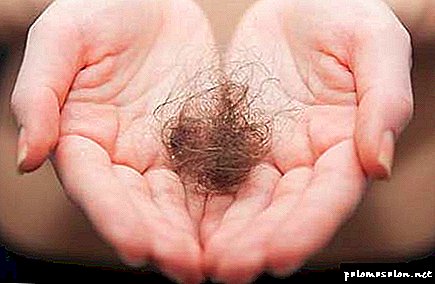
With obvious signs of a decrease in the density of the hair and the presence of bald patches, the diagnosis is not difficult. The main measures are aimed at identifying the cause of the development of pathological changes in the scalp. The trichologist will help to find the right direction in diagnosis and will detail in detail the scheme for how to treat alapetia of one or another species.
Diagnosis is the first and important step in the effective treatment of alopecia!
Diagnostics consists of a whole complex of diagnostic methods and tests consisting of:
- The stages of the examination of the hormonal background - the functional activity of the thyroid gland, detection of the level of male hormones, examination of the viability of immune functions.
- Examination excluding or confirming syphilitic infection.
- RPR test and serological studies.
- Definitions of "B" and "T" lymphocytes and samples for easy removal of hair (light stretching).
- Microscopic examination of the hair shaft and bald spots on fungal flora.
- Examination of the biopsy from the affected areas for detection of ringworm, cicatricial pathology frolicking due to granulomatous lesions of sarcoidosis, inflammatory reactions in the skin caused by lichen planus or systemic lupus erythematosus.
- Spectral analysis - identifying the deficiency or excess of trace elements in the structural tissues of the hair.
Drugs and methods of treatment
In the treatment of alopecia nodal, diffuse and androgenic nature, complex methods are used including:
- Acceptance of biostimulants - neuropeptides, tissue extracts of the placenta, etc.
- Vitamin-mineral complexes, including the group of vitamin "B" and "E",
- Tinctures and extracts of plant origin (Valerian, Eleutherococcus, Plantain Juice and Kalanchoe,
- Phyto irritants - arnica, goroditsy, nettle, etc.
- Manual techniques - various massage methods are recommended with therapeutic and cosmetic masks, lotions, body and paraffin masks, cryomassage,
- The use of hardware techniques - galvanization, ionophoresis, comb darsonvalization, microcurrent therapy, laser therapy or electrotrichenesis. (not applicable in case of pronounced autoimmune component),
- The use of injection mesotherapy.
In the treatment of androgenic alopecia in women, hardware techniques are prescribed only after the correction of hormones. Because, they can provoke an increased influx of androgens into the follicles. Recommended:
- photochromotherapy methods
- use of microcurrents,
- electrotrichogenesis and darsonvalization,
- drugs that block alpha reductase,
- group of natural phytoestrogens,
- biostimulating, vasoactive and strengthening agents.
In severe pathology, various methods of autotransplantation are used.
The prognosis for treating alopecia depends on the extent of hairline damage. Complete loss of curls in women is rare. In the androgenic course, the prognosis completely depends on the timeliness and selection of the correct therapy.
When alopecia areata, many facts of spontaneous recovery are recorded. But recurrences are not uncommon. Unfavorable prognosis in the development of total atrichia. In this case, the process is irreversible.
Causes of hair loss
Among the adverse factors predisposing to the occurrence and development of alopecia, include:
- Polycystic ovary. As a result of this disease, hormones change, a smaller amount of estrogen is produced in a woman’s body, and testosterone levels, on the contrary, increase.
- Anemia, iron deficiency in the body adversely affect the state of the body as a whole, and the condition of the hair in particular.
- Period of pregnancy and breastfeeding. During this period, the woman's body spends a large amount of nutrients on the development of the fetus, the formation of breast milk. It adversely affects the condition of the hair. After the completion of pregnancy and lactation, the thickness of the hair coat is gradually restored.
- Fungal infections.
- Thyroid dysfunction (hypothyroidism).
- Chronic infections and diseases of the autoimmune nature.
- Acceptance of certain drugs. Antibiotics, hormonal agents, antidepressants, laxatives, weight loss drugs, and antitumor drugs can adversely affect the state of the hair coat.
- Cosmetic procedures affecting the scalp, such as coloring, straightening hair, perming.
- Exposure to low temperatures scalp burns.
- Improper nutrition in particular, insufficient intake of zinc, as well as alcohol, excessive amounts of caffeine.
Read about the relationship between baldness in women and psychosomatics on our website.
Medications
For the treatment of alopecia, several groups of drugs are used:

- Preparations based on selenium (for example, Minoxidil). The active substances penetrate deep into the skin, restore blood circulation and metabolic processes in this area, stimulating hair growth.
- Hormonal preparations in the form of tablets or creams (products containing female hormones) are indicated for the treatment of alopecia in girls, associated with hormonal disorders, for example, during menopause.
- Hormonal drugs, prevent excessive testosterone production and its derivatives that adversely affect the hair follicles.
- Complexes containing vitamins and trace elements.
About the best drugs for the treatment of alopecia, read here.
Folk remedies
The following recipes of traditional medicine have positive properties:

- A decoction of the roots of burdock. The root of the plant must be chopped, pour boiling water, heated in a water bath within 1 hour. Means strain, rub into the hair roots.
- From the juice of aloe, honey and garlic, you can prepare a mask for the hair, stimulating their growth. To do this, add aloe juice and honey to garlic pulp (use all ingredients in equal amounts). Mask applied for 15 minutes wrapped with polyethylene, terry towel for insulation.
- Active hair growth and provides the use of an onion mask. Juice 1 onions mixed with 1ch. honey The mixture is applied to the hair for 20 minutes wash off with shampoo.
Duration of treatment
Treatment of female alopecia is a complex and time consuming process. Of course, the duration of the course in each case is determined by the doctor individually and depends on the stage of the disease, the severity of its symptoms. In most cases the duration of treatment is 3-6 months.
In some cases (for example, in cicatricial alopecia), conventional treatment is useless. In this case, the patient needs a hair transplant. For more information about modern methods of transplantation, including non-invasive methods and the price of this procedure, you can find on our website. But, the result is not always positive (sometimes the transplanted follicles do not survive), and the disease continues to progress.
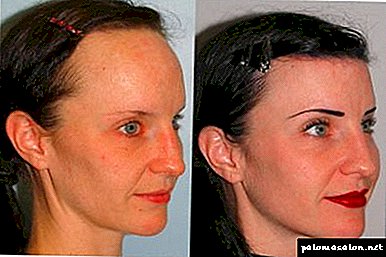 Increased hair loss is a situation that requires treatment.
Increased hair loss is a situation that requires treatment.
Numerous factors can lead to negative consequences, some of these causes are very serious diseases that need to be addressed.
The treatment of alopecia is, primarily in treating the cause which led to its development. In this case, treatment can be varied.
These include the use of medications, topical preparations, and physiotherapy. In the most extreme cases, the patient is shown surgical treatment - hair transplant.
Useful video
Watch the following video about alopecia in women and the need for diagnosis:
About the causes of female baldness and types of alopecia:


 The consequence of pathological diseases in the complex structure of the central nervous system,
The consequence of pathological diseases in the complex structure of the central nervous system, Androgenic activity
Androgenic activity Infectious processes,
Infectious processes, In the progressive stage of the flow, areas of damaged hair are defined simply and clearly. Foci of bald areas in size increase. Ladies have a rather old age with gray hair, mostly only pigmented hair falls out, and the gray hair itself remains untouched. The impression is a one-time graying,
In the progressive stage of the flow, areas of damaged hair are defined simply and clearly. Foci of bald areas in size increase. Ladies have a rather old age with gray hair, mostly only pigmented hair falls out, and the gray hair itself remains untouched. The impression is a one-time graying, Survey confirming or excluding syphilitic infection
Survey confirming or excluding syphilitic infection Examination of the biopsy from the areas of damage to the formation of ringworm, cicatricial disease, which develops as a result of granulomatous lesions of sarcoidosis, educational reactions in the skin caused by
Examination of the biopsy from the areas of damage to the formation of ringworm, cicatricial disease, which develops as a result of granulomatous lesions of sarcoidosis, educational reactions in the skin caused by  Spectral analysis, which will help detect an excess or deficiency of trace elements in the structural tissues of the hair,
Spectral analysis, which will help detect an excess or deficiency of trace elements in the structural tissues of the hair, Serological studies
Serological studies Vitamin and mineral complex, which carries a group of vitamins E and B,
Vitamin and mineral complex, which carries a group of vitamins E and B, darsonvalization, galvanization, however, is not used with a pronounced autoimmune component,
darsonvalization, galvanization, however, is not used with a pronounced autoimmune component, Manual methods (we recommend different methods of massage with medical and cosmetic masks, body massage, cryomassage, paraffin masks, lotions).
Manual methods (we recommend different methods of massage with medical and cosmetic masks, body massage, cryomassage, paraffin masks, lotions). Drugs that block alpha reductase,
Drugs that block alpha reductase,